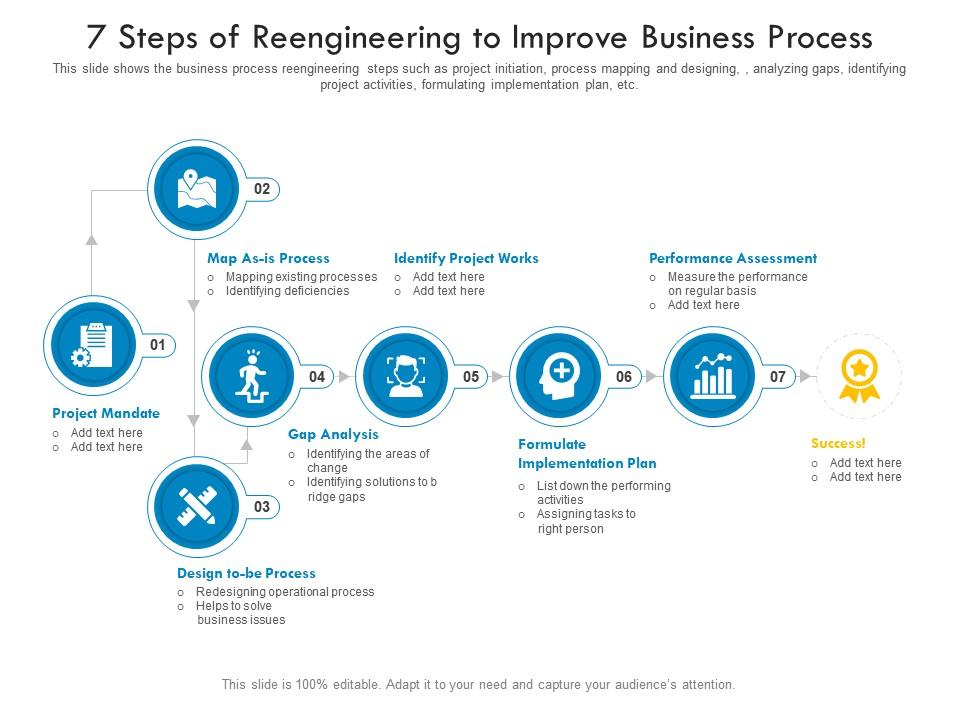7 Business Process Redesign Steps: A Complete Guide to Transformation in 2025
As businesses face growing competition, digital transformation, and evolving customer expectations, inefficiencies in outdated processes can significantly hinder growth. Business process redesign (BPR) is a strategic approach that helps organizations optimize workflows, eliminate redundancies, and improve overall efficiency.
At Savvycom, a leading software development company, we have helped enterprises across BFSI, healthcare, education, retail, and manufacturing streamline operations through process automation and digital transformation. This article outlines 7 critical business process redesign steps, providing insights and real-world examples to guide organizations through successful transformation.
What is Business Process Redesign (BPR)?
Business Process Redesign (BPR), also known as Business Process Reengineering, involves a fundamental rethinking and radical redesign of business processes to achieve significant improvements in critical aspects such as quality, output, cost, service, and speed. Unlike incremental improvements, BPR seeks to overhaul existing processes to deliver substantial performance enhancements. Kissflow+3Bain+3Informa TechTarget+3
Why is Business Process Redesign Important?
Implementing business process redesign steps is crucial for organizations aiming to remain competitive and responsive to market changes.
-
Enhanced Efficiency: Streamlining processes eliminates redundancies, reduces waste, and optimizes resource utilization, leading to more efficient operations.
-
Improved Customer Satisfaction: Redesigned processes often result in faster service delivery and higher-quality products, directly enhancing customer experiences.
-
Cost Reduction: By identifying and eliminating unnecessary steps, organizations can significantly reduce operational costs.
-
Increased Agility: A well-executed BPR enables organizations to adapt more quickly to market dynamics and emerging opportunities.
7 Critical Business Process Redesign Steps

1. Define Clear Objectives Aligned with Business Goals
The first one in 7 business process redesign steps is identifying what needs improvement and setting clear, measurable goals. Organizations often embark on BPR projects to achieve outcomes such as:
-
Reducing operational costs by eliminating inefficiencies
-
Improving customer experience by accelerating response times
-
Increasing scalability through automation and digitization
Example: A manufacturing company aiming to reduce production time by 20% must first identify which processes contribute most significantly to delays. By focusing on these areas, the company can set realistic targets and measure progress effectively.
2. Assemble a Cross-Functional Team for Holistic Insights
BPR impacts multiple departments, requiring collaboration among stakeholders. A cross-functional team comprising operations managers, IT specialists, finance professionals, and customer experience experts ensures:
-
A comprehensive understanding of process inefficiencies
-
Alignment of redesign efforts with business needs
-
Smooth implementation with minimal resistance
Example: When a retail company sought to streamline its supply chain, it formed a team comprising members from procurement, logistics, and sales. This collaborative approach led to the identification of bottlenecks and the development of more efficient workflows.
3. Map the Existing Process to Identify Pain Points
A detailed process mapping exercise provides a clear visualization of how tasks flow from start to finish. By identifying bottlenecks, redundant steps, and dependencies, businesses gain a deeper understanding of where inefficiencies lie.
Example: Identifying Delays in Healthcare Operations
A hospital analyzing its patient discharge process found that multiple handoffs between doctors, nurses, and billing departments caused unnecessary delays. By mapping out the process, they identified redundant approvals that could be automated, reducing discharge times by 40%.
4. Perform a Root Cause Analysis to Address Core Issues
Many organizations treat symptoms rather than the root cause of inefficiencies. Using techniques like the Five Whys and Fishbone Diagrams, businesses can uncover deeper operational issues:
-
Are employees performing redundant tasks due to poor system integrations?
-
Are approvals delayed because of unclear delegation of authority?
-
Are manual workflows increasing errors and compliance risks?
Example: Manufacturing Delays Due to Inefficient Quality Checks
A manufacturing company experiencing frequent defects traced the issue to inconsistent quality inspections. By redesigning the process with automated AI-based quality checks, defect rates dropped by 25%.
5. Design and Model the New Process with Scalable Solutions
With insights from process analysis, organizations can reengineer workflows to eliminate inefficiencies. Modern business process redesign leverages:
-
Automation tools to streamline repetitive tasks
-
AI-driven decision-making to reduce human error
-
Low-code platforms for easy implementation of new workflows
Example: AI-Powered Claims Processing in Insurance
An insurance company redesigned its claims approval process by integrating AI-based document verification, cutting processing times from weeks to days while reducing fraud detection errors by 30%.
6. Implement Process Redesign with Agile Iterations
Rather than executing a full-scale rollout, a phased approach minimizes disruption. Using pilot programs, businesses can test new processes in controlled environments before wider adoption.
Key Strategies for a Smooth Implementation:
-
Provide comprehensive employee training to prevent resistance
-
Establish clear change management protocols
-
Use real-time analytics dashboards to monitor progress and refine processes
7. Monitor, Evaluate, and Continuously Optimize
BPR is not a one-time initiative; it requires ongoing monitoring and refinement. Companies should establish Key Performance Indicators (KPIs) such as:
-
Reduction in processing time (e.g., loan approvals from 14 days to 5 days)
-
Cost savings from automation (e.g., reducing manual labor costs by 40%)
-
Customer satisfaction scores (e.g., increased Net Promoter Score after service improvements)
Example: Retail Supply Chain Optimization with Predictive Analytics
A global retailer implemented AI-driven demand forecasting to optimize inventory levels. By continuously refining its predictive models, it reduced stockouts by 20% and overstock issues by 30%, leading to higher profitability.

Looking For a Trusted Tech Partner?
We’ll help you decide on next steps, explain how the development process is organized, and provide you with a free project estimate.
Case Studies: Real-World Applications of 7 Business Process Redesign Steps
To understand the true impact of business process redesign (BPR), let’s explore how organizations across different industries have successfully implemented it to drive efficiency, reduce costs, and improve customer satisfaction.
Case Study 1: Ford’s Accounts Payable Transformation
Challenge:
Ford Motor Company, a global leader in automotive manufacturing, faced inefficiencies in its accounts payable department. The existing process required over 500 employees to manually handle invoices, leading to excessive paperwork, delays, and high operational costs.
Business Process Redesign Approach:
-
Instead of simply automating the existing workflow, Ford completely redesigned the process.
-
The company implemented an invoiceless processing system, leveraging an integrated database that automatically matched purchase orders with deliveries.
-
Eliminated the need for manual invoice approvals and significantly reduced human intervention.
Results:
-
75% reduction in the number of employees handling accounts payable.
-
Elimination of redundant paperwork, leading to faster processing times.
-
Lower operational costs and improved financial accuracy.
-
Enhanced supplier relationships due to faster invoice settlement.
This case exemplifies how BPR goes beyond automation, it fundamentally rethinks how a process operates to maximize efficiency.
Case Study 2: IBM’s Order Management Overhaul
Challenge:
IBM, a global technology giant, struggled with a fragmented order management system. Different regions had their own unique processes, leading to inconsistencies, delays, and high administrative costs.
Business Process Redesign Approach:
-
Standardized the order fulfillment process across multiple global locations.
-
Implemented an automated workflow system that allowed seamless integration between different business units.
-
Reduced redundant approvals and centralized data management.
Results:
-
50% reduction in order processing time.
-
Cost savings of millions of dollars due to streamlined operations.
-
Enhanced customer satisfaction through faster and more reliable order fulfillment.
-
Improved interdepartmental collaboration, leading to better decision-making.
IBM’s transformation highlights how BPR enables organizations to break down operational silos and create a more unified, efficient workflow.
Case Study 3: A Healthcare Provider’s Patient Intake Optimization
Challenge:
A large healthcare provider in the U.S. faced long patient wait times and administrative inefficiencies in its intake process. Paper-based forms, manual data entry, and fragmented communication between departments led to delays and frustrated patients.
Business Process Redesign Approach:
-
Introduced an AI-driven digital check-in system that allowed patients to complete pre-visit forms online.
-
Integrated electronic health records (EHRs) with a centralized database to reduce duplicate data entry.
-
Streamlined internal communication between nurses, doctors, and administrative staff.
Results:
-
30% reduction in patient wait times.
-
40% decrease in paperwork-related errors.
-
Increased staff efficiency, allowing doctors to focus more on patient care rather than administrative tasks.
-
Improved patient satisfaction and engagement.
This case study demonstrates how digital transformation plays a crucial role in business process redesign, especially in service-oriented industries.
Case Study 4: Amazon’s Warehouse Logistics Revamp
Challenge:
As Amazon grew, its warehouse operations struggled to keep up with increasing order volumes. The existing manual picking and packing process was inefficient, causing shipping delays and rising fulfillment costs.
Business Process Redesign Approach:
-
Integrated robotic process automation (RPA) into warehouse logistics.
-
Optimized warehouse layouts using AI-driven algorithms to reduce unnecessary movement.
-
Introduced predictive inventory management to ensure high-demand items were always stocked in strategic locations.
Results:
-
50% improvement in order fulfillment speed.
-
Lower labor costs due to automated processes.
-
Enhanced customer satisfaction with faster and more accurate deliveries.
-
Scalability, allowing Amazon to efficiently handle peak shopping seasons.
This case highlights how technology-driven process redesign can create exponential improvements in efficiency and customer experience.
Key Takeaways from These Case Studies
-
Technology plays a vital role in modern business process redesign. From automation to AI, digital tools enable businesses to streamline operations at scale.
-
Eliminating redundancies is just as important as automation. Ford’s success stemmed from removing invoices altogether rather than simply digitizing them.
-
Customer-centric redesign leads to tangible benefits. Faster service delivery, improved communication, and reduced errors all contribute to higher customer satisfaction.
-
Cross-functional collaboration is essential. BPR is most effective when all stakeholders – IT, operations, finance, and customer service – are involved in the process.
FAQs: More ABout Business Process Redesign Steps
What industries benefit the most from business process redesign?
BPR is beneficial for BFSI, healthcare, education, retail, manufacturing, and logistics, where streamlined operations can enhance efficiency, compliance, and customer experience.
What role does automation play in business process redesign?
Automation eliminates repetitive tasks, reduces human error, and accelerates processes. Modern BPR integrates AI, RPA (Robotic Process Automation), and cloud-based solutions to drive digital transformation.
For more simple explanation for Business Process Redesign steps, check out this video:
Conclusion
A successful 7 business process redesign steps involves a structured approach to identifying inefficiencies, implementing scalable improvements, and continuously optimizing workflows. By following these seven key steps, organizations can drive cost savings, operational efficiency, and better customer experiences.
For businesses seeking expert guidance, Savvycom, a leading software development company, provides tailored business process management solutions that leverage automation, AI, and digital transformation along with business process redesign steps to maximize efficiency.
Tech Consulting, End-to-End Product Development, Cloud & DevOps Service! Since 2009, Savvycom has been harnessing digital technologies for the benefit of businesses, mid and large enterprises, and startups across the variety of industries. We can help you to build high-quality software solutions and products as well as deliver a wide range of related professional services.
Savvycom is right where you need. Contact us now for further consultation:
- Phone: +84 24 3202 9222
- Hotline: +1 408 663 8600 (US); +612 8006 1349 (AUS); +84 32 675 2886 (VN)
- Email: [email protected]


